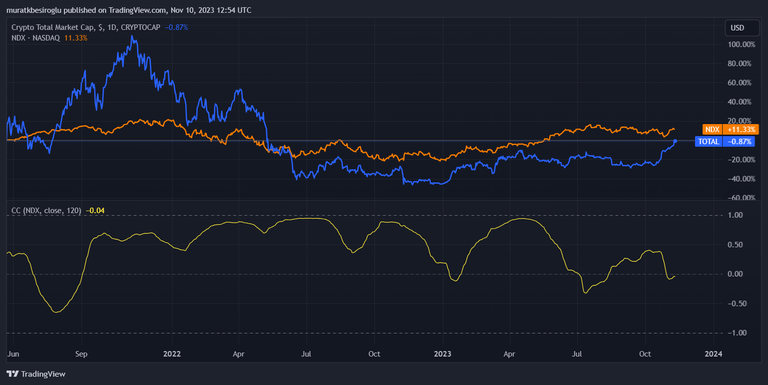
Portfolio managers pay attention to risk reduction following modern portfolio theory. To minimize risk, reversely correlated assets and investment instruments not associated with others are preferred. Those who wanted to market cryptocurrencies by 2022 were highlighting their lack of correlation with other assets, among all their other great features. In particular, Bitcoin was presented as a risk-hedging tool in this context.
One of the distinguishing features of 2022 was the increasing correlation of cryptocurrencies with stocks. This situation became evident from the first days of the year. This increase in correlation was bad news for the crypto market, as prices drop whenever cryptocurrencies become highly correlated with stocks. This correlation occurs due to the influence of the FED. The FED's rapid increase or decrease in liquidity leads to a rise in correlation.
The asset class with which cryptocurrencies have the highest correlation is technology stocks. These two asset classes are sensitive to interest rate changes. While examining the stock-cryptocurrency relationship, I compare Nasdaq 100 and total crypto market values in this context. In the chart below, the orange line shows the change in the Nasdaq 100 index, the blue line indicates the difference in the crypto total market cap, and the yellow line shows the correlation between the two. I used the 120-day average because correlation values fluctuate rapidly daily.

A correlation coefficient close to 1 indicates a strong correlation. A correlation coefficient close to -1 indicates a robust inverse correlation. When the correlation coefficient is close to zero, we understand there is no relationship between the two variables. In this context, what does the yellow graph tell us?
2021 was the year of monetary expansion. In the chart, we see that Nasdaq 100 and cryptocurrencies are rising. The rise of cryptocurrencies has been volatile. That's why the correlation decreased significantly during the middle of the year. We see that 2021 is completed with a moderate correlation. The correlation increased in 2022 because monetary tightening began. The high correlation continued in the first three quarters of the year. This situation also shows that concerns about the FED were high. The correlation decreased in the last months of 2022, and an increase was seen in both Nasdaq and cryptocurrencies in the first quarter of 2023. In the second quarter, the correlation increased, and price declines began. We know the correlation fluctuates around zero in the year's second half. And prices started to rise again.
TL;DR
Can the Nasdaq 100 crypto correlation be a leading indicator to predict future prices? My experiments using different time intervals showed that this data alone did not yield meaningful results. Better results can be achieved when evaluated together with expectations regarding liquidity conditions.
While the FED rapidly shrunk its balance sheet in the first half of 2022, technology stocks and crypto assets had a high correlation. Because both asset classes like low interest rates and abundant liquidity. In 2020, when COVID-19 created earthquakes in the financial market, we again encountered a high correlation. So, when expectations deteriorate rapidly, the correlation increases. The rapid monetary expansion causes a moderate correlation. Without significant macroeconomic development, cryptocurrencies and stocks will continue on their path.
Thank you for reading.



